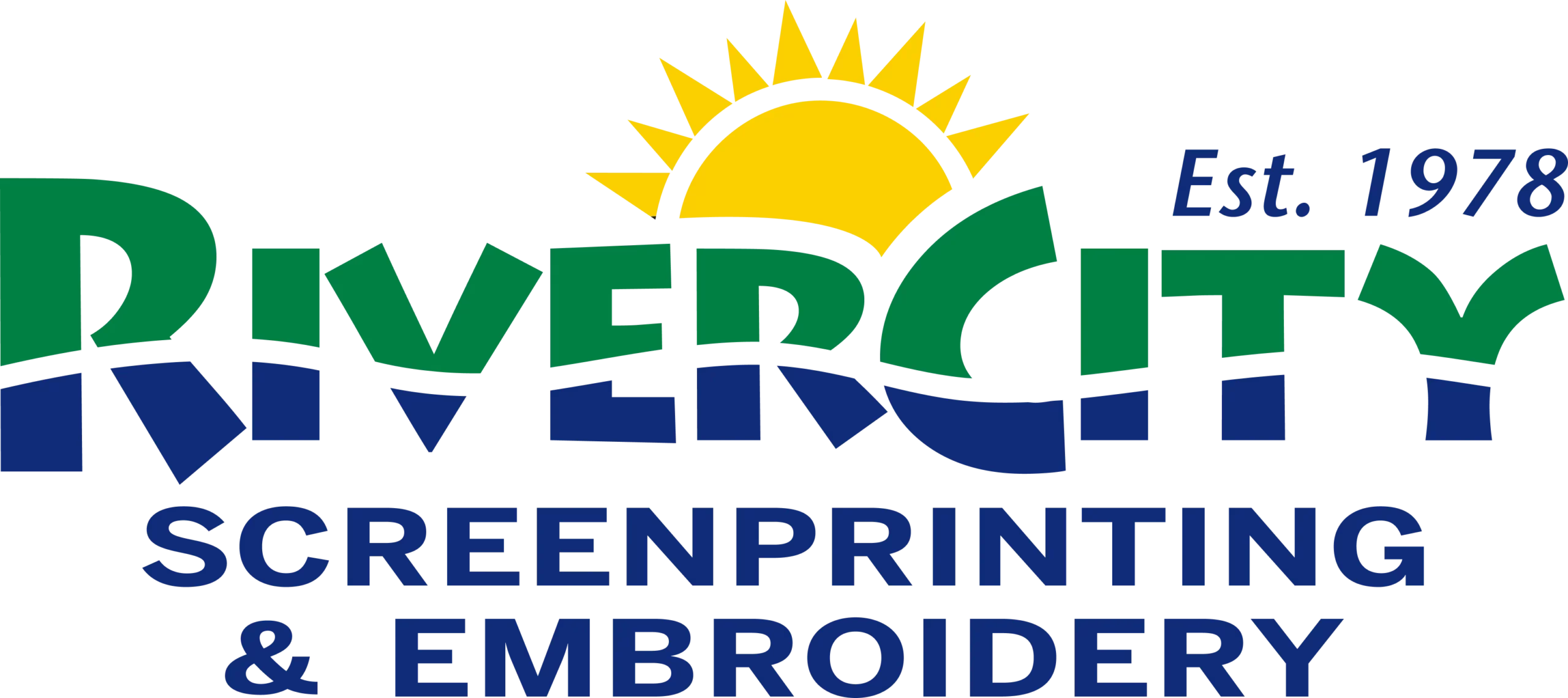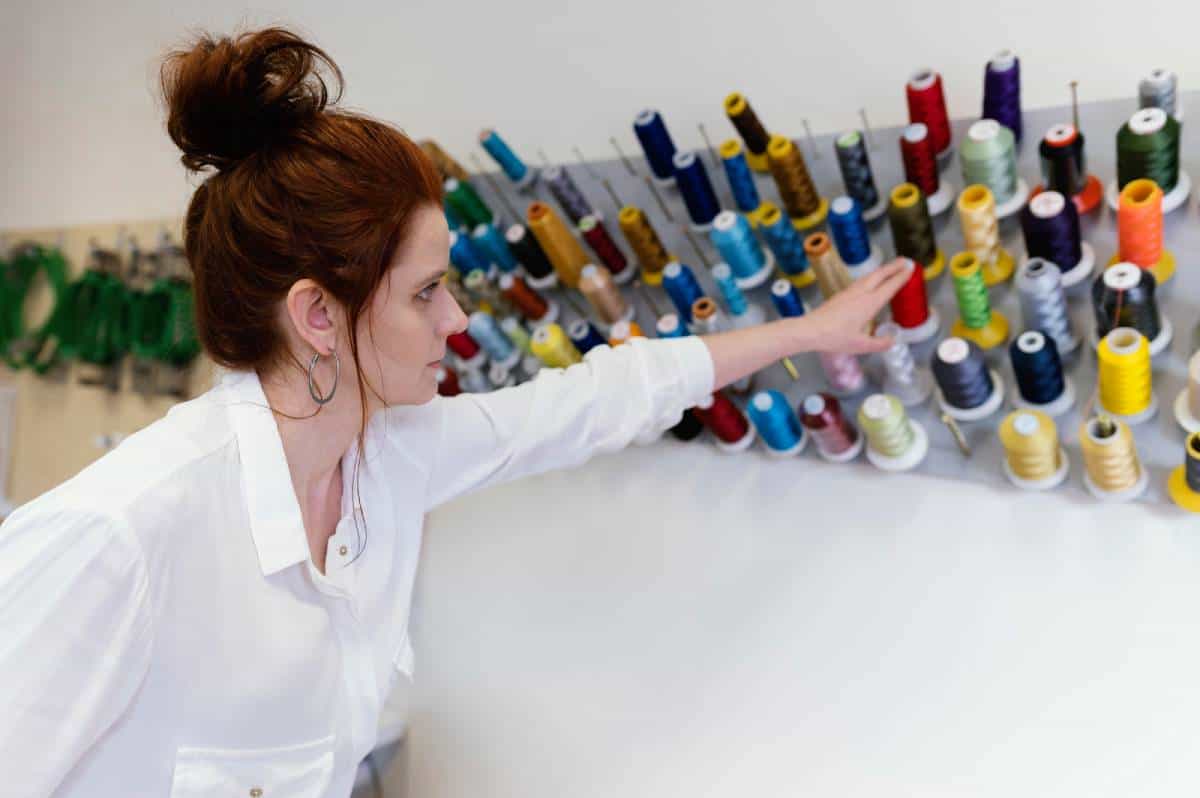Choosing the right way to customize your business uniforms is important. It can affect how people see your brand, how happy your employees are, and how you present yourself overall.
As you start a new year with new uniforms, it’s important to know the differences between Austin screen printing and Austin embroidery.
Key Customization Methods:
- Screen Printing: This technique involves transferring ink onto fabric through a mesh screen. It is ideal for large designs and bulk orders.
- Embroidery: Utilizing thread and needle, this method creates stitched logos and designs. It offers a professional look and durability.
We’ll cover several important factors to help you make an informed decision:
- Types of fabrics suitable for each method
- Advantages and disadvantages
- Cost considerations
- Durability and quality assessments
- Design complexity suitability
Understanding these elements will guide you in selecting the best option for your business needs as you kick off the New Year with new uniforms.
Understanding Screen Printing
Screen printing is a method that involves transferring ink onto fabric using a mesh screen. A stencil, or screen, is created for each color in the design. Ink is pushed through the screen onto the material, allowing for vibrant and durable prints. This technique allows for high-quality images and can be used on various surfaces.
Types of Fabrics Suitable for Screen Printing
The following types of fabrics are commonly used for screen printing:
- Cotton: Known for its softness and breathability, it is one of the most popular choices.
- Polyester: Offers durability and resistance to wrinkles, making it ideal for sportswear.
- Blends: Cotton-polyester blends combine comfort with strength.
Advantages of Screen Printing
Screen printing offers several advantages, including:
- Cost-Effectiveness: Particularly beneficial for bulk orders. The more you print, the lower the cost per item becomes.
- Suitability for Large Designs: Excels in producing large graphics with bold colors that stand out.
Disadvantages of Screen Printing
Despite its advantages, screen printing has some limitations:
- Limitations with Small Text and Detail: Fine details may become lost during the printing process. Small text can appear blurry or indistinct, making it less suitable for intricate designs requiring precision.
Exploring Embroidery
Embroidery is a customization method that uses needle and thread to create designs on fabric. This process can be accomplished with either specialized machines or by hand, allowing for intricate patterns and logos to be stitched onto garments.
Suitable Fabrics for Embroidery
- Polo Shirts
- Jackets
- Business Shirts
- Caps
These fabrics provide the necessary support for embroidery, ensuring the designs maintain their integrity over time.
Advantages of Embroidery
- Durability: Embroidered logos are resistant to fading and wear, making them suitable for high-use garments. The use of durable polyester threads enhances this longevity.
- Professional Appearance: Embroidery adds a sophisticated touch to uniforms, contributing to a polished and cohesive look.
Disadvantages of Embroidery
- Limitations on Gradient Colors: Achieving smooth color transitions is challenging with embroidery, as it generally relies on solid colors.
- Intricate Designs: Highly detailed images may not translate well into embroidered formats, as the stitching can obscure finer details.
Embroidery offers distinct benefits that cater to specific business needs while also presenting certain challenges based on design complexity.
Cost Comparison: Screen Printing vs Embroidery
When considering the cost of embroidery and screen printing, it’s essential to understand the breakdown of expenses associated with each method.
Screen Printing Costs
- Color Count: The primary factor influencing the cost in screen printing is the number of colors used in your design. Each additional color requires a new mesh screen, which increases production costs.
- Bulk Orders: Screen printing is often more cost-effective for large orders due to lower per-item prices at higher quantities.
Embroidery Costs
- Flat-rate Pricing Model: One of the main advantages of embroidery is its flat-rate pricing. Regardless of the number of colors in your design, you pay a consistent rate per piece. This makes budgeting easier, especially for businesses with complex designs.
- Setup Fees: While setup fees may apply, they typically remain constant across different designs as long as they fall within size limits.
Durability and Quality Assessment
When evaluating the durability of screen printing and embroidery, it is important to consider various factors such as washing, heat exposure, and wear over time.
Screen Printing:
- Vulnerable to cracking and fading, especially under high temperatures.
- Ink may melt or peel when subjected to heat from ironing or drying.
- Performance can diminish after multiple washes, particularly if not properly cared for.
Embroidery:
- Offers superior durability due to the stitching process.
- Resistant to heat and retains integrity through numerous wash cycles.
- Maintains a professional appearance even after extensive use.
Quality Aspects
The quality of the final product varies significantly between the two methods:
Texture:
- Embroidery provides a textured feel with a raised effect that adds depth.
- Screen printing delivers a smooth finish, ideal for bold graphics.
Appearance:
- Embroidered designs appear polished and sophisticated, making them suitable for corporate settings.
- Screen printing excels in vibrant colors and intricate large designs but lacks the same level of refinement in detail.
Understanding these differences aids in selecting the right method based on your business’s needs. Each has its strengths, ensuring that both durability and quality are prioritized in your decision-making process.
Suitability Based on Design Complexity
Choosing between screen printing and embroidery often depends on the design complexity of your artwork. Each method has its strengths and limitations that can influence the final output.
Screen Printing
Screen printing is a versatile method that works well for various designs. Here are some situations where screen printing shines:
- Large designs with bold graphics: If your artwork features big, eye-catching elements, screen printing can reproduce them accurately and vibrantly.
- Simple logos and text that are easily recognizable: When your design consists of basic shapes or fonts, screen printing can achieve crisp lines and solid colors.
Screen printing is also recommended when:
- Your design includes multiple colors, especially gradients: Screen printing allows for precise color application, making it suitable for complex designs with different hues.
- You require vibrant visuals on lighter fabrics: The ink used in screen printing sits on top of the fabric, resulting in bright and vivid prints on light-colored materials.
Embroidery
Embroidery is an excellent choice for designs that require a more textured and professional look. Here are some scenarios where embroidery works best:
- Intricate designs such as detailed logos or patterns: If your artwork contains fine details or intricate elements, embroidery can bring them to life with its stitching technique.
- Text that needs a professional finish, like corporate branding: Embroidered text has a polished appearance, making it ideal for businesses looking to convey professionalism.
Embroidery is also worth considering when:
- The design is limited to a smaller area (e.g., left chest): Embroidery is best suited for smaller spaces where precision is crucial.
- You want a textured, three-dimensional appearance: Embroidery adds depth and dimension to designs, creating a tactile effect that stands out.
Best Practices for Artwork Preparation
To ensure successful results with both screen printing and embroidery, it’s essential to prepare your artwork correctly. Here are some guidelines to follow:
Screen Printing
- Use vector files for clean lines and scalability: Vector graphics maintain their quality regardless of size, making them perfect for screen printing.
- Ensure color separation is clear to avoid muddiness in prints: If your design has overlapping colors, make sure they are separated properly in the file to prevent blending during the printing process.
Embroidery
- Provide high-resolution images to capture detail: The better the quality of your image, the more intricate details can be reproduced through embroidery.
- Simplify intricate designs into manageable segments for stitching: Complex designs may need to be broken down into smaller parts to ensure smooth stitching without any issues.
Factors to Consider When Choosing Between Methods
Choosing between screen printing and embroidery requires a thorough understanding of the differences between customization methods. Several factors can guide this decision:
- Garment Usage: Determine the context in which the uniforms will be used. For professional settings, embroidery often provides a polished and durable appearance. Casual environments may benefit from the bold and colorful designs achievable through screen printing.
- Fabric Type: The choice of fabric significantly impacts your decision. Heavier fabrics like jackets or polos tend to work better with embroidery, while lighter materials such as t-shirts and hoodies are more suited for screen printing.
- Design Complexity: As discussed previously, intricate designs with gradients favor screen printing, while simpler logos and text can be effectively embroidered.
- Durability Needs: Consider how frequently garments will be worn and washed. Embroidery offers superior durability against heat and wear, making it ideal for high-use items.
Evaluate these factors carefully to make an informed choice that aligns with your business needs. The right method not only enhances your brand image but also meets practical requirements for your uniforms.
Start The New Year Fresh For Your Business
Evaluating the cost and quality of embroidery versus screen printing is key for making an informed decision.
Consider these factors:
- Business Needs: Identify your target audience and the message you want to convey.
- Design Complexity: Match your artwork style with the capabilities of each method.
- Fabric Choices: Ensure compatibility between fabric type and customization method.
Selecting the right option not only enhances brand visibility but also guarantees professionalism. If you’re trying to determine the best options for your needs, contact us today! Our experts will discuss your goals and provide a customized quote for your uniform or custom t-shirt estimate in Austin
FAQs
What is the difference between screen printing and embroidery?
Screen printing involves applying ink to fabric through a stencil, making it ideal for large designs. Embroidery, on the other hand, uses thread to stitch designs onto fabric, providing a durable and professional appearance. Each method has its own advantages and disadvantages depending on the design complexity and fabric type.
What are the advantages of screen printing?
Screen printing is cost-effective for bulk orders and works well with large designs. It is suitable for fabrics like cotton and polyester, making it a popular choice for businesses looking to customize uniforms at a lower cost.
What fabrics are suitable for embroidery?
Embroidery is ideal for fabrics such as polo shirts and jackets. The use of durable polyester threads enhances the quality and longevity of embroidered designs, making them suitable for a variety of garment types.
How do the costs compare between screen printing and embroidery?
Screen printing costs can vary based on the number of colors used in the design, while embroidery typically follows a flat-rate pricing model regardless of color count. Businesses should evaluate their design needs to determine which method offers better value.
Which method is more durable: screen printing or embroidery?
Embroidery generally offers greater durability compared to screen printing, particularly under conditions such as heat and washing. However, both methods have their own strengths in terms of quality and texture, which should be considered based on intended use.
What factors should I consider when choosing between screen printing and embroidery?
Key factors include the complexity of the design, usage context of the garments, fabric type, and overall garment purpose. Understanding these elements will help you make an informed decision that best suits your business needs.

